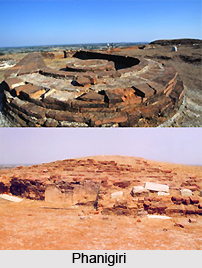 Phanigiri in Telangana is a Buddhist monastic complex, which is also known as Buddha Vihara. Lies at about 125 kilometers from Hyderabad, which is now the capital of Telangana and Andhra Pradesh for 10 years.
Phanigiri in Telangana is a Buddhist monastic complex, which is also known as Buddha Vihara. Lies at about 125 kilometers from Hyderabad, which is now the capital of Telangana and Andhra Pradesh for 10 years.
Phanigiri, an archaeological site in Telangana is located near the National Highway No. 9. Phanigiri is considered as a Buddhist site as great as the Nagarjunakonda and Amaravathi, which are now the property of State Department of Archaeology and Museums. The vast hillock in Phangiri housed a Buddhist monastery about 2000 years ago. It is derived the name from the shape that resembles a snake-hood.
The excavations in Phangiri are conducted by the Archaeological Survey of India. And this is yielded a Maha Stupa, a stone pillared congregation hall, three Viharas, two Apsidal Chaityagrihas, sculptured panels including Jataka stories, Brahmi inscriptions belonging to the rulers of Satavahana Dynasty and Ikshavaku dynasty.
The coins that are found from Phangiri belong to Mahatalavarasa, Satavahana and Ikshavaku Kings. Besides from the early historic cultural materials, Phangiri aged from 1st Century B.C. to 3rd Century A.D. This is the only site which yielded panels carved with Jataka Stories after Amaravati, Nagarjuna Konda and Goli.
Phanigiri in Telangana is a vital and promising Buddhist habitation site equally important as Amaravathi and Nagarjuna konda in Andhra Pradesh. Apart from the Buddhist remnants, there are medieval temples belonging to the Kakatiya dynasty that is from 12th to 13th Century A.D.
Phangiri is located at the foot of the hillock, on the second terrace and also inside the village, found in dilapidated stage. The site is acting as the leisure and historical tourism site to the tourists of both national and international level.
The first three seasons of excavations in Phangiri held in 2002-2003, 2009-2010 and 2010-2011. The archaeologists have unearthed extensive Buddhist relics of the 2nd century AD and 4th century AD.
The structural remains of a strong past were identified with excavations of Chaityagrihas, a stone pillared congregation hall with 64 pillars, three Viharas with thick brick walls, sculptured panels, Brahmi inscriptions, the Roman coins and Persian pottery, that were found apart from some cultural materials of Phangiri.
Phangiri is considered as the importance place in Telangana of the historic value of the monastic complex.



















